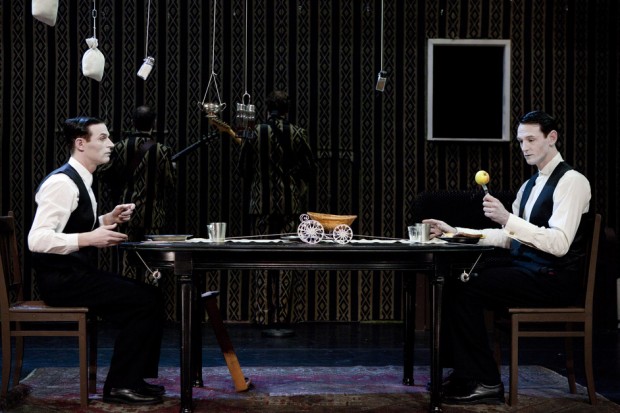You have no items in your cart. Want to get some nice things?
Go shopping
Was it just this critic, or did we spend most of last year in Bloomsbury ballroom, necking gin and tonic and cavorting to jazz bands? 2013 brought back the ’20s in full swing. Probably indebted to the release of The Great Gatsby in May (literally indebted – there’s a real mark-up on Tanqueray), every fashion-forward Londoner seemed to be embracing the Roaring Twenties. This year’s line-up for the London International Mime Festival celebrated the return of the Jazz Age, and none more so than Jakop Ahlbom and his show Lebensraum, which ran at the Southbank Centre’s Purcell Room from the 11th to 15th January. A silent movie in a theatre, Ahlbom creates an atmosphere at once comic and disquieting, guaranteed to surprise and enchant even the most cynical of theatre-goers.
Entering the space feels like walking into your grandma’s living room, or Noel Coward’s mind. Somewhere on the bed in the semidarkness are Reinier Schimmel and Yannick Greweldinger, hardly distinguishable, even though one is a foot shorter than the other. They are our Buster Keatons for the evening; Lebensraum is based on Keaton’s 1920 release The Scarecrow. Our story begins with two inventors, and the set is so reminiscent of the opening of Keaton’s film that the breakfast table could have been lifted off of the screen. For those unfamiliar with the silent classic, cruets, condiments and cutlery are suspended over their heads at the table with a complicated pulley system. With uncompromising accuracy and precision, the two diners pull on various weights dangling above them, sending ketchup and water bottles flying across the room. And they rarely look up from their plates.
The accuracy is enduring. A performance based primarily on mime, there is no margin for error here. Schimmel and Greweldinger, directed to perfection by Ahlbom, make excellent use of the “fixed point” technique. Popular with the great names of mime, Etienne Decroux, Jacques Lecoq, and Marcel Marceau, in fixed point, one part of the body (let’s say the hand) stays in the same place in space while the body moves around it. The importance of fixed point is that it establishes a “reality”; we can see that the hand can’t move – maybe because it is pushing against an invisible wall, or holding onto an invisible pole – but the fixed point, and the way the body moves around the fixed point, establishes the shape of the reality that is not really there. Confused yet? It is the basis of various famous mime techniques, including “trapped in a glass box”, and enables the audience to see what the mime artist is imagining. To put it simply, it’s really hard. Schimmel and Greweldinger are masters of their art. We accept their reality immediately. The way they interact, although highly slapstick, is utterly believable.
How we’ve managed to get through three paragraphs of the review without mentioning Silke Hundertmark as “The Girl” is testament only to the unwavering talent of our two leading men. If Schimmel and Greweldinger are good, then Hundertmark is out of this world. She is impressive in the way that knocks you for six, leaving you speechless, mouth flapping like a guppy. Her entrance is as a mannequin, standing absolutely straight, smiling emptily into the audience. There’s a predictability to her introduction; she’s going to stand still until they leave and then she’ll move. But, conversely to our predictions, the more she is thrown around by the inventors, the more doubts creep into the mind. Nobody can stay that rigid; it’s impossible. She is launched into the air, hitting the table as stiff as a rod, then bounces off and thuds onto the floor, landing as log-like as when she left the inventor’s arms. By the time the gentlemen do leave the stage, I’m utterly convinced that she is an admittedly uncannily human mannequin, but I haven’t even seen her blink. Then she moves. Everyone gasps. They have used our conjecture against us, and we were all fooled.
The remainder of the show is an exquisitely timed fracas that builds and builds into a cathartic, anarchic crescendo. The room reveals more flipping walls and secret passages than you could imagine, accompanied by a mighty wurlitzer performance from Alamo Race Track, who blend into the wallpaper in their striped pyjamas. The performers’ exhaustion from this energetic performance is revealed only in the sweat that pours over their white-painted faces. Ahlbom’s Lebensraum reminisces on an otherwise bygone era of Chaplinesque belly-laugh entertainment, while enlisting jaw-dropping performances that have rarely been seen before.


About EJ Stedman
EJ Stedman is a writer and producer, currently studying at the Royal Central School of Speech and Drama. She is a company director of Dacha Studios LTD which produces short films. EJ has written for Critical Voices with Animations Online, DEADBIRD Reviews, and is the editor-in-chief of Poison Chalice Cafes. In her spare time, EJ enjoys the seaside, reading too much, and the musical stylings of Billy Joel.





One comment